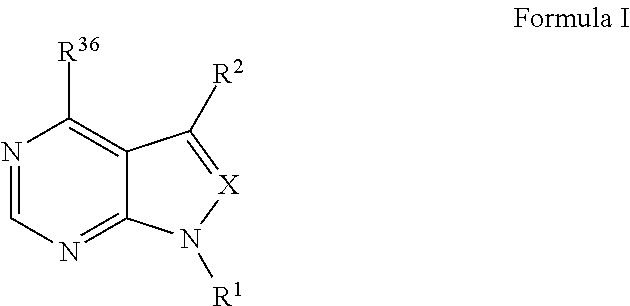Methods and compositions for treatment of ophthalmic conditions
a technology for ophthalmic conditions and compositions, applied in the field of methods and compositions for treating ophthalmic conditions, can solve the problems of increased vascular leakage and retinal edema, loss of visual field, and death of photoreceptor and retinal pigment epithelial cells, and achieve the effect of lowering intraocular pressure and alleviating the symptoms of glaucoma
- Summary
- Abstract
- Description
- Claims
- Application Information
AI Technical Summary
Benefits of technology
Problems solved by technology
Method used
Image
Examples
example 1
Expression and Inhibition Assays of p110α / p85α, p110β / p85α, p110δ / p85α, and p110γ
[0314]Class I PI3-Ks can be either purchased (p110α / p85α, p110β / p85α, p110δ / p85α from Upstate, and p110γ from Sigma) or expressed as previously described (Knight et al., 2004). IC50 values are measured using either a standard TLC assay for lipid kinase activity (described below) or a high-throughput membrane capture assay. Kinase reactions are performed by preparing a reaction mixture containing kinase, inhibitor (2% DMSO final concentration), buffer (25 mM HEPES, pH 7.4, 10 mM MgCl2), and freshly sonicated phosphatidylinositol (100 μg / ml). Reactions are initiated by the addition of ATP containing 10 μCi of γ-32P-ATP to a final concentration 10 or 100 μM and allowed to proceed for 5 minutes at room temperature. For TLC analysis, reactions are then terminated by the addition of 105 μl 1N HCl followed by 160 μl CHCl3:MeOH (1:1). The biphasic mixture is vortexed, briefly centrifuged, and the organic phase ...
example 2
Expression and Inhibition Assays of Abl
[0316]The compounds described herein can be assayed in triplicate against recombinant full-length Abl or Abl (T315I) (Upstate) in an assay containing 25 mM HEPES, pH 7.4, 10 mM MgCl2, 200 μM ATP (2.5 μCi of γ-32P-ATP), and 0.5 mg / mL BSA. The optimized Abl peptide substrate EAIYAAPFAKKK is used as phosphoacceptor (200 μM). Reactions are terminated by spotting onto phosphocellulose sheets, which are washed with 0.5% phosphoric acid (approximately 6 times, 5-10 minutes each). Sheets are dried and the transferred radioactivity quantitated by phosphorimaging.
example 3
Expression and Inhibition Assays of Hck
[0317]The compounds described herein can be assayed in triplicate against recombinant full-length Hck in an assay containing 25 mM HEPES, pH 7.4, 10 mM MgCl2, 200 μM ATP (2.5 μCi of γ-32P-ATP), and 0.5 mg / mL BSA. The optimized Src family kinase peptide substrate EIYGEFKKK is used as phosphoacceptor (200 μM). Reactions are terminated by spotting onto phosphocellulose sheets, which are washed with 0.5% phosphoric acid (approximately 6 times, 5-10 minutes each). Sheets are dried and the transferred radioactivity quantitated by phosphorimaging.
PUM
| Property | Measurement | Unit |
|---|---|---|
| weight percent | aaaaa | aaaaa |
| weight percent | aaaaa | aaaaa |
| size | aaaaa | aaaaa |
Abstract
Description
Claims
Application Information
 Login to View More
Login to View More - R&D
- Intellectual Property
- Life Sciences
- Materials
- Tech Scout
- Unparalleled Data Quality
- Higher Quality Content
- 60% Fewer Hallucinations
Browse by: Latest US Patents, China's latest patents, Technical Efficacy Thesaurus, Application Domain, Technology Topic, Popular Technical Reports.
© 2025 PatSnap. All rights reserved.Legal|Privacy policy|Modern Slavery Act Transparency Statement|Sitemap|About US| Contact US: help@patsnap.com



